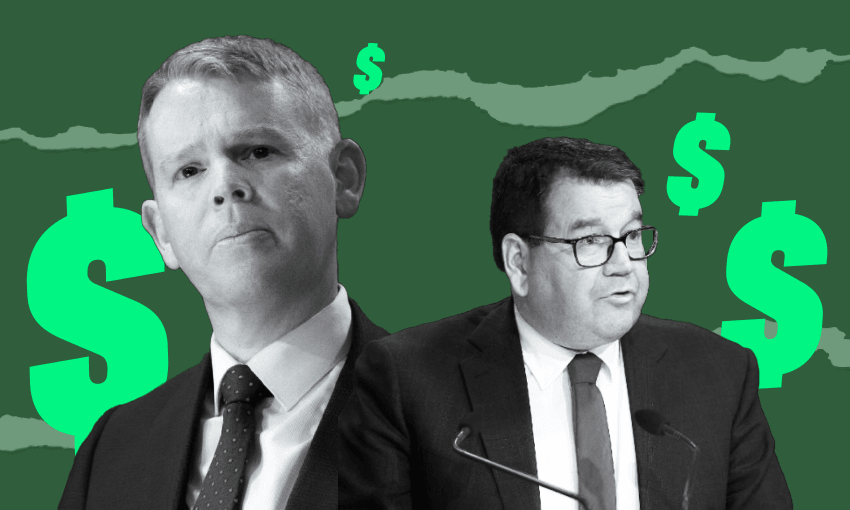No surprises in today’s final fiscal announcement – but clear evidence Labour believes its request that National ‘show it the money’ is working.
Prime minister Chris Hipkins and finance minister Grant Robertson delivered Labour’s fiscal plan – its vision for how it will raise money, and what it will spend – at the Cordis hotel in central Auckland this morning. Despite the more straitened times predicted in the pre-election fiscal update (Prefu), the party says it will still reach surplus by 2026-27, in line with its previously announced plans, and with what the National Party says it would do were it to form the next government.
This is not to say that the recent Prefu has had no impact on the plan. Robertson said in a statement that “to support meeting these fiscal rules… we will drive further savings and efficiencies across government on top of the $8 billion we have found this year.”
The plan reaffirmed its previously announced commitments, like the removal of GST from fruit and vegetables and free dental care for under 30s, while underlining its opposition to National’s tax cuts, and foreign buyers tax. “Now is not the time for additional taxes or to promise billions of dollars in unfunded tax cuts which would add to inflation and take money away from health, education and housing,” said Robertson.
The fiscal plan was accompanied by an analysis from Infometrics principal economist Brad Olsen which endorsed the plan – with mild caveats. “Together, the level of funding available for remaining cost pressures appears reasonable compared to historical cost pressure needs,” though the brief went on to note that “we reiterate Treasury’s message in Prefu that ‘significant trade-offs will be required’.”
The analysis also noted that Infometrics “has not independently modelled or costed individual policy proposals”. When asked about that at the press conference following the announcement, the Taxpayer’s Union critique of the costings of the GST removal from fruit and vegetables was raised. Was this an example of why Infoemtrics needed to test the modelling too? Hipkins dismissed the Taxpayers’ Union as a “National Party front group”, and said it was possible the policy might in fact prove less costly than budgeted.
One mild surprise: in recognition of the significantly chastened economic outlook versus that forecast in the May budget, Robertson signalled an expansion of the cost-cutting announced in August. “We will drive further savings and efficiencies across government on top of the $8 billion we have found this year,” he said in a statement. The fiscal plan describes the relatively small scale, centring on “$50 million of recent savings resulting from the Covid-19 public health response, which were not previously factored into Treasury forecasts.”
Still, it maintains the general posture of “fiscal discipline” and “low net debt”, each of which was underlined at the press conference following the release of the plan. Robertson was extensively questioned on the scant $660m remaining unallocated in this year’s budget, pointing out that recent settlements with teachers and nurses had meant the largest outstanding spending issues had been resolved. When asked what he would do were another weather event like the Auckland Anniversary floods or Cyclone Gabriel to arise, he simply said, “we’ll deal with it”.
Recent contention around the scale of budget operating allowances – new spending, essentially – was addressed with a descending trio of spending envelopes. The plan announces an “operating allowance for Budget 2024 has been set at $3.5 billion of new spending. Budget allowances then decline to $3.25 billion in Budget 2025 and $3 billion in Budget 2026”. It attributes the reduction in operating allowances to a forecast decline in inflation, to within the Reserve Bank’s 1-3% target range.
Ominously, ANZ sent out a release within an hour of the plan landing which appeared to call into question that projection. It said the bank’s economists “continue to expect a [Reserve Bank interest rate] hike at the November meeting and risks are tilting towards even more being required in 2024.” They attribute this to the “wealth effect” of house prices increasing again.
Overall the plan contained no major surprises, instead seeking to position Labour as the party of fiscal discipline and low debt, set against what it portrays as a National party wedded to irresponsible tax-and-cuts. As Hipkins pointedly noted, while Labour was late with its fiscal plan, National has still yet to release its own, despite overseas voting beginning today. It sets the stage for the Newshub debate tonight to be fought on fiscal issues, ground Labour has not historically favoured, but on which it clearly believes it can now win.





